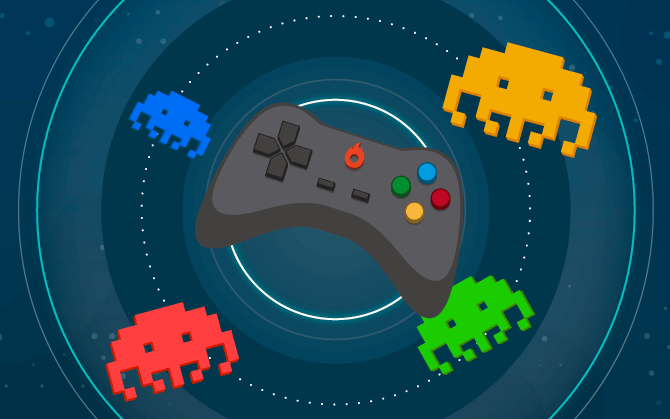
Using gamification to engage your audience and generate more sales
Learn how gamification can boost your business.

What will we see in this post
Have you ever heard of gamification?
This resource can offer major improvements in your team’s motivation, your audience’s engagement and of course, in your sales.
Turning an activity into a game can be decisive to make it more attractive and to generate better results.
Several types of segments can benefit from this idea, all you need is to implement it properly.
However, creating a game isn’t an easy task. You need to know your audience well and develop mechanisms focused on keeping these people in touch with the activity.
In this post, you’ll learn more about the idea behind gamification, the importance of this concept, and how to apply it best in your company. Keep reading!
What is gamification?
Gamification is a concept revolving around using elements extracted from games to increase engagement of participants in a certain activity. It involves transforming a conventional activity into something similar to a game.
Overall, games have always had mechanisms designed specifically to engage their audience, both board games and video games. The intention is to always make people keep playing and pursuing an increasingly better performance.
A company may adopt a system of points with a championship board with those who have the best performance in the team, for example.
You can define a table with scores for specific actions, such as closing a deal or suggesting an effective improvement. Your team will be motivated to improve in order to be put on the board and the company will reap the benefits.
Why you should invest in gamification
The pursuit for your audience’s engagement should always be among your priorities. If your audience forgets that your brand exists, it risks losing space to your competitors in customer preference.
Gamification emerges as an effective resource to ensure this engagement.
By transforming your customers’ contact with your brand into a game, they’ll feel motivated to stay in touch and perform actions that are of the company’s interest.
Because it’s so versatile and effective, gamification is a very valuable resource both for your interaction with customers and for impacting a team of employees in a positive manner.
Therefore, this resource can be used both for your external and internal audience.
How to use gamification in your marketing strategy
Gamification can serve as a powerful marketing channel for your company. If your goal is to impact your audience in a positive manner, you can reap the benefits that this concept can generate.
To do so, you need to implement this idea correctly, since creating a scoring system and waiting that this will solve your problem isn’t enough.
Check out 6 ways of using gamification in your marketing strategy:
1. Understand who your persona is
Because gamification has the purpose of impacting your audience and motivating it to engage with your brand, you can’t start planning without really understanding your persona.
This is the time to analyze not only your audience’s age group and gender, but also their needs and desires.
What is usually a decisive factor in getting your attention? Answering this question is very important for the definitions in the following steps.
2. Search for game references
Gamification is based on gaming mechanics, so you cannot plan your actions without obtaining references from them. This isn’t about copying ideas, but getting the inspiration necessary to create your own.
Both board and electronic games can serve as a base. However, capturing references from other gaming experiences is even more valuable, whether from companies in the same segment as yours or from others.
3. Map your interaction points
A gamification experience takes place from the interaction points that a customer has with a brand. An e-commerce purchase, for example, can serve as part of the mechanics of the game being developed.
For your planning to be complete, you need to direct your attention to all of these interaction points. Go from the more conventional to the least remembered.
4. Develop the gamification mechanics
After the preliminary steps are concluded, it’s time to create your gamification experience.
Since the purpose here is to increase your audience’s engagement, you need to take into account people’s motivations in order to create an attractive and satisfying system.
It’s very important that the rules of the game be easy to understand and consult.
Remember to use technology to improve the experience, such as a mobile app or some connection with social media.
5. Promote your game
Even after you activate your gamified experience, it needs to be well promoted to really attract the audience you’re expecting.
This is the time to use the full potential of your marketing channels in order to let your audience know about your new game and start participating.
It’s also important to make the rules very clear when informing them. Don’t allow any questions to linger, and keep your customer support team ready to interact with those who send questions.
6. Analyze your results
After you’ve developed your gamification mechanics and have activated it, you need to keep an eye on your results. Only by doing this will it be possible to be sure that your ideas are really generating the expected engagement returns.
If the results aren’t adequate, try to understand in which steps your users are stopping. From there, make the necessary adjustments to remedy the case and give a new chance to their gamified experience.
Adopt gamification in your strategy now!
Now that you’re familiar with gamification and understand the importance of this concept for your success, you can use the tips above to structure your idea.
Take care so as not to create something too complicated, since the purpose here is to always appeal to the largest possible portion of your audience and keep it in constant touch with your brand.
Want to learn other ways to boost your audience’s engagement? If so, check out this article on how to create GIFs in your marketing strategy.




